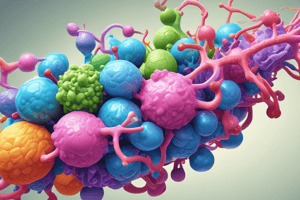Podcast
Questions and Answers
Viruses are not considered living things because they lack _____________.
Viruses are not considered living things because they lack _____________.
False (B)
The main difference between the lytic and lysogenic cycles is that the lytic cycle results in the _____________ of the host cell, while the lysogenic cycle involves _____________.
The main difference between the lytic and lysogenic cycles is that the lytic cycle results in the _____________ of the host cell, while the lysogenic cycle involves _____________.
False (B)
The 8 taxonomic divisions are: Domain, Kingdom, Phylum, Class, Order, Family, Genus, and _____________.
The 8 taxonomic divisions are: Domain, Kingdom, Phylum, Class, Order, Family, Genus, and _____________.
False (B)
Binomial nomenclature shows relatedness by indicating that organisms with the same genus name are _____________.
Binomial nomenclature shows relatedness by indicating that organisms with the same genus name are _____________.
Antibiotics primarily work on _____________ organisms by targeting specific cellular processes or structures.
Antibiotics primarily work on _____________ organisms by targeting specific cellular processes or structures.
Eukaryotic organisms have a _____________, while prokaryotic organisms do not.
Eukaryotic organisms have a _____________, while prokaryotic organisms do not.
DNA replication occurs during the process of Meiosis.
DNA replication occurs during the process of Meiosis.
Vestigial structures provide evidence of evolution by showing features that were once useful to an organism but are no longer functional.
Vestigial structures provide evidence of evolution by showing features that were once useful to an organism but are no longer functional.
Genetic drift is a mechanism of evolution that occurs through natural selection.
Genetic drift is a mechanism of evolution that occurs through natural selection.
Meiosis results in the formation of haploid gametes.
Meiosis results in the formation of haploid gametes.
Adaptation types include allopatric and sympatric speciation.
Adaptation types include allopatric and sympatric speciation.
Homologous structures are features that have similar functions but different evolutionary origins.
Homologous structures are features that have similar functions but different evolutionary origins.
Mutation is a mechanism of evolution that introduces new genetic variations into a population.
Mutation is a mechanism of evolution that introduces new genetic variations into a population.
Artificial selection is a process where humans selectively breed individuals with desired traits to perpetuate those traits in successive generations.
Artificial selection is a process where humans selectively breed individuals with desired traits to perpetuate those traits in successive generations.
Punctuated equilibrium suggests that evolution occurs in sudden bursts separated by long periods of little or no change.
Punctuated equilibrium suggests that evolution occurs in sudden bursts separated by long periods of little or no change.
The process of crossing over occurs during prophase I of meiosis.
The process of crossing over occurs during prophase I of meiosis.
Flashcards are hidden until you start studying




